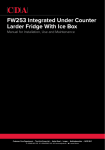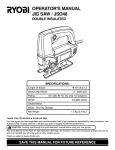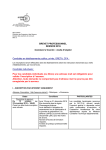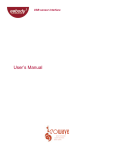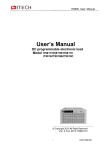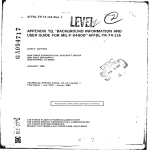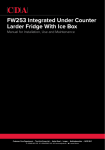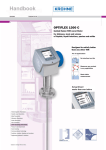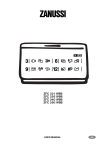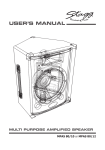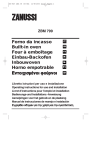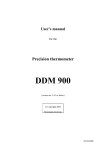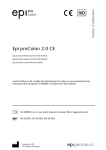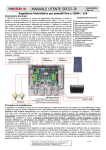Download PT60 - Pondus Instruments
Transcript
Pressure and differential pressure transmitter PT60 Electronic transmitter with a wide range of process connections. Stainless steel housing with hygienic design. PT60 a series of pressure transmitters with great flexibility. Modulary built. A wide range of process connections and electronics can be choosen. Hygienic design stainless steel, no dirt collecting gaps or pockets . Easy to clean and minimal risk for corrosion. EMC rugged construction. Housing in stainless steel with excellent shielding. Constructed for washing with high pressure cleaners. IP67 housing. Different electronics. - Analogue, 4-20 mA - HART, 4-20 mA - Profibus PA - FOUNDATION fieldbus (pending) Can be delivered with 19 different directly connected process connections for both pressure and differential pressure. 150°C media temperature (short time 200°C). Accuracy of 0,1 %. Transmitter types, order codes: The transmitters order codes for different configurations can be found from the table below. All combinations are not possible, see next page for exceptions. PT60 x x x - x x x x x D e s cription Ele ctronics D e s ign D iaphragm Conne ction Span min.-max. M e as . type Filling liquid Suffix Analogue 4-20 mA A HART 4-20 mA H Profibus PA PA Foundation Fie ldbus (7) FF D e s ign Figure 1 Figure 2 Figure 3 Figure 4 Intrins ic s afe (1) E Ligthning prote cte d L Stainle s s s te e l 1.44621 (5) 3 Has te lloy C-276 (5) 4 Tantalum (5) 5 R 1/2" e xte rnal. 1 N PT 1/2" e xte rnal. 2 R 1 1/2" e xte rnal 3 Flange 80 mm/3" 4 Flange 50 mm/2" 5 R e movable during ope r. 6 D IN 11851/40 mm 7 SM S R d60-6 8 Clamp 38 9 Clamp 51 A R JT 1 1/2" C D R D Conne ction D D IN 11851/50 mm E Hygie nic front conne ction P Varive nt 2" V D iffe re ntial pre s s ure (3) G D iff. pre s s ure with flange (3) H D P with capillary tube (3) T Trans mitte r with capillary tube (3) N 0,24-7 kPa 1 1,2-35 kPa 2 6,7-200 kPa 4 0,067-2 M Pa 6 0,14-4 M Pa (4) 7 0,27-8 M Pa 7 0,5-15 M Pa 8 Atmos phe ric pre s s ure 0 Abs olute pre s s ure 2 Silicon oil (2) Oil fre e de s ign (6) Empty H Ordering example: Threaded transmitter with external R1/2” connection, pressure range 0-90 kPa for atmospheric pressure and HART electronics (silicon oil filling and Hastelloy diaphragm) will have order code: PT60H-4140 with calibrated measuring range 0-90 kPa. (1) Not with analogue electronics. (2) FDA approved silicon oil. (3) Type G with connection 1/4” NPT thread. Type H with flange 80 mm/3” one side. Type T see description on next page. (4) Only for connection 8 (SMS Rd60-6). (5) See next page for permitted combinations. (6) Oil free and filled with halocarbon. (7) Pending. Transmitter types, description: Threaded transmitter R 1/2" and NPT 1/2”. (1 and 2) The threaded transmitter with connection to R 1/2” thread is intended for clean media. At a media temperature higher than 90ºC, a cooling pipe is used to prevent too high temperature at the sensor. The threaded connection is normaly sufficient to keep the transmitter in place. At specific conditions or wall installation the transmitter can be supported and reinforced with an installation kit. (Exceptions: Normally not available with tantalum diaphragm.) the limits depends on flange type.) Hygienic clamp connected transmitter. Clamp38, Clamp51, hygienic front connection and Varivent. (9, A, P and V) A clamp connected transmitter is used when special hygiene requirements are needed, such as those in the food and pharmaceutical industry. The design meets ISO 2852 and the transmitter is easy to install and remove. If clamp 38 connection is not available, the optional connector piece, clamping ring and gasket ring may be used. Connection details for clamp 51, hygienic front Threaded transmitter with connection and Varivent is available extended diaphragm, R1 ½ ”. upon request but not available from (3) stock. This transmitter connection with (Exceptions: Normaly not available a connection to a 1½” thread is with tantalum or stainless steel intended for fibre-rich and viscous diaphragm. media. The extended front The highest pressure range for diaphragm is in connection with clamp 38/51 and Varivent is 2 MPa. the media without any pocket Note that the limits depends on inside the tank or pipe. clamping ring type.) An optional adapter is available for connection to a 2" thread and Hygienic screw connected an optional welding sleeve for transmitter. R1½”. There are no additional DIN11851/40 mm, SMS Rd60-6, requirements on the installation. DIN11851/50 mm. (7, 8, C, E) The transmitter may also be A screw connected transmitter connected inside a threaded giving a hygienic connection, for R1½” cylinder, such as a pipe example, used in the Dairy sleeve or shut-off valve. industry. The exposed diaphragm (Exceptions: has direct contact with the media Not available with tantalum which make it possible for the diaphragm and pressure range 14 transmitter to measure even and 35 kPa. viscouse liquid media, without The highest pressure range for this becoming silted up. connection type is 4 MPa). The transmitter is installed in accordance with the Rd 60-6 Flange connected transmitter. connection of SMS 1146, DIN 405 Flange 80 mm/3”, Flange 50 and DIN 11851. The transmitter is mm/2” and DRD flange. (4, 5 screwed to the connector. and D) (Exceptions: Normaly not available A flange connected transmitter is with tantalum or stainless steel intended for level measurement in diaphragm. open tanks with liquid media, The highest pressure range for even with fibre rich and/or DIN11851/40 is 2 MPa. The highest viscous media. The risk of pressure range for SMS Rd60-6 is 8 blockage is eliminated by the MPa.) large area of the exposed diaphragm. Transmitter removable during The transmitter is clamped operation. (6) between standard flange rings. This transmitter type is intended The transmitter fits slip-on for liquid media, even with flanges of ANSI or DIN type. For viscous or fibre-rich media. The transmitters with flange extended diaphragm is in connection, the type of flange has connection with the media to be stated at the time of order. without any pocket inside the (see Accessories). tank or pipe. PT60 with flange 50 mm/2" and six The transmitter can be exchanged holes, for use with MWP10 is during operation and comprises supplied upon request. three parts; the transmitter, a ball (Exceptions: Not available with valve and a welded casing/ tantalum diaphragm combined compression flange. This with pressure range 14 and 35 kPa. compression flange is designed to The highest pressure range for this fit an ANSI or DIN 80 mm/3” connection type is 4 MPa. Note that flange and may be installed to measure levels according to the hydrostatic principle. (Exceptions: Normaly not available with tantalum diaphragm. The highest pressure range for this transmitter type is 2 MPa.) Differential pressure transmitter. (G, H and T) Differential pressure transmitters is used to meausre the difference between two pressures. The transmitter types G and H can withstand high static pressures, both one- and doublesided, (up to 15 MPa). The transmitter type G has threaded connection and type H has one side threaded and the other side with flange 80 mm. They are used for level measurements in pressure vessels and flow measurements of gases, liguids and vapour. Other application areas are differential pressure measurements across filters or heat exchangers, and pressure measurements with narrow measurement ranges where there is a danger of high one-sided pressure overload. The differential pressure transmitter type T can be delivered with two process connections 3-9, A, C, D, E och V. One side is directly connected to the transmitter and the other side with a capillary tube (normal lenght of the capilary tube is 2000 mm, other length upon request). (Execeptions: Type G: Threaded connection is not available with tantalum or stainless steel diaphragm. Flange connection is not available with Tantalum diaphragm.The highest pressure range is 0,8 MPa. Type T: Highest static pressure is the same as the overload for the pressure range. Same exceptions as for the choosen process connection.) Transmitter with capillary tube. (N) This transmitter type is designed with the connection (with the measuring diaphragm) separated from the transmitter housing. The media pressure is transferred via a capillary tube (normal lenght of the capi lary tube is 1000 mm, other length upon request) to the sensor located in the transmitter housing. This type can be delivered with process connections 3-9, A, C, D, E and V. The transmitter type is designed for applications with high vibration levels or high ambient temperatures. Withstands extremly high media temperartures (max 275 degrees C). (Exceptions: Same exceptions as for the choosen process connection.) Function: Transmitter for Pressure and Level The PT60 uses a piezo-resistive pressure sensor which is connected to the pressure of the medium via a capillary tube and a diaphragm. Media pressure applied to the diaphragm is transferred via silicon oil to the pressure sensor. The oil completely fills the cavity in the sensor, the capillary tube and the cavity above the diaphragm. This means that the diaphragm movement is very small at pressure changes. The capillary To transmitter electronics Electronics Reference tube Sensor Slit for atmospheric pressure Capilary tube Diaphragm The pressure of the medium is transferred to the sensor via silicon oil relaying diaphragm movements tube protects the pressure sensor from transient pressure surges. To ensure that the sensor has the correct reference pressure, the rear side is connected to ambient atmospheric pressure, via a tube, designed in order that air passes “cold surfaces” closest to the pressure connection of the transmitter. Any humidity in the air will condense on these surfaces. The condensate flows out and the remaining air in the tube stays dry. Additionally, the reference pressure connection is designed to prevent flushing water from entering. PT60 has microcomputer-based electronics, which communicate with the outside world with 4 to 20 mA signal as well as HART communication (PT60H). The electronics measure and converts the output signal from the pressure dependent sensor bridge to digital values. Furthermore, the total resistance of the sensor bridge is measured and these values are converted to digital temperature values. The electronics perform compensation for temperature drift of the sensor by means of compensation values entered at the factory calibration and at the same time the temperature measurement is also calibrated. Compensation for the nonlinearity in the sensor is done in the same manner. Different kinds of transfer functions, such as linear, square root, curves..., can be selected. The electronics perform the calculation for the selected transfer function and then the digital value is converted to analogue for the 4 to 20 mA current loop. The digital value can also be read via HART (PT60H) communication in optional engineering units, percentage or current. PT60 can be configured/calibrated to a certain extent by means of keys and switches in the connection space and fully by means of a hand terminal or a PC via HART (PT60H) communication. Transmitter for Differential Pressure The transmitter has a central piezoresistive sensor connected to the membrane chambers via two capillary tubes. Each of the two process media pressures act on a separating membrane that have a small spring To transmitter electronics Electronics Sensor Measuringdiaphragm Overload diaphragm The pressure is transferred from the media to the sensor element via the separating diaphragms by means of silicon oil. constant. An overload membrane with adapted spring constant is located between the two separating membranes. The membrane chambers and the sensor are filled with silicon oil. The pressure on both sides of the overload membrane is transferred to the sensor by means of the silicon oil. At a pressure difference between the two separating membranes within the measuring range of the transmitter, all three membranes will move freely. At overload exceeding the measuring range one of the separating membranes will however lay against the profiled surface while the overload membrane still can move freely. The differential pressure across the sensor can in that way not increase further even if the differential pressure across the separating membranes increases. This protects the sensor against overload and transient pressure surges. The electronics perform compensation for temperature drift of the sensor by means of compensation values entered at factory calibration, and at the same time the temperature measurement is also calibrated. Compensation for the nonlinearity in the sensor is done in the same manner. Different kinds of transfer functions, such as linear, square root, curves..., can be selected. The electronics perform the calculation for the selected transfer function and converts the digital value to an analogue signal for the current loop 4 to 20 mA. The digital value can also be read via HART (PT60H) communication in optional engineering quantity, percentage or current. PT60 can be configured/calibrated to a certain part by means of keys and switches in the connection space and fully by means of a hand terminal or a PC via HART (PT60H) communication. PI100 PI100 is a software tool on CDROM for Windows95/98/2000/XP and Windows NT for configuration, calibration and documentation. PI100 contains a database with available transmitter types. The program can configure transmitter specific values and perform maintenance, output signal and factory calibration. Furthermore, PI100 performs copying of current configuration, backup on to hard disc, transmitting/receiving via standard HART communication and a selftest with alarm functions. PI100 contains online presentation of help functions, data sheets and user manual. Hand terminal For parameter settings a hand terminal of HART type can be used, see more detailed description in PI100 User Manual. Approvals PT60 with connections 7, 8, 9, A, D, E and V are approved for 3A. PT60 is approved by DNV and explosionproof, EEx ia IIC T4, by NEMKO (according to the EU directive ATEX) . PT60 are CE approved according to the EU directives for pressure equipment, PED, and EMC. To concider To obtain longtime and faultless operation of PT60 there are some important factors to consider when choosing transmitter type and at installation. Al types Pressure transmitters with piezoresistive sensors is designed to withstand a specific overload (see data). If the pressure on the diaphragm exceeds this limits, irrespective if it is for a long or short time, the sensor will be broken permanently. Consider if such pressures will arise in the plant and choose the right type of sensor. If there is for example valves closing fast in connection to the transmitter high pressure surges can arise Can there for example be steam surges? The measuring diaphragm is the most exposed and easily affected part of the transmitter. If the media is corrosive consider choosing the right diaphragm material. If there is any uncertainty please contact us for advise. If existing diaphragm types is not sufficient it is possible to deliver transmitters with diaphragm coatings, for example teflon, epoxy, rubber. Please contact us for information. Even though a diaphragm material is sufficient for a corrosive media it will be slightly affected. This imply that the measurement will be slightly changed over time (especially the zero point). This can be corrected by performing a maintenance calibration or a recalibration. The transmitters electronic- and electric connection housing is approved for IP66. Use round signal/supply cable and tighten the cable feed through firmly. Make sure that the electronic housing cover is tight. If the transmitter is installed in a dirty environment, make sure that the reference slit (see picture page before) always is open for the atmospheric pressure. In plants with high vibration levels it is important to secure that the transmitters performance is sufficient. The most certain is to measure the vibrations amplitude resp. acceleration. The transmitters are designed and tested for: 3-25 Hz, amplitude 1,6 mm 25-60 Hz, amplitude 0,21 mm 60-100 Hz, accel. 19,6 m/s2 (Standards: IEC770 and DNV Certification note 2.4 location class B.) If vibration levels exceeds this consider using the transmitter type N (see Transmitter Types Description). Transmitter removable during operation. (connection 6) There are certain considerations that must be considered for this transmitter type. The diaphragm is more exposed on this type because the transmitter is pushed in/out of the valve. Assure that the valve is not plugged or closed when the transmitter is pushed in. If soo the sensor might be permanently damaged. This transmitter type has a small diaphragm and it is sensitive to damaged or corroded diaphragms. A maintenance calibration or recalibration might be required periodically. Warning: The transmitter cannot be replaced at high pressure due to the large force required to push the transmitter back into the valve housing. The area affected by the pressure is 7.5 cm2. The transmitter must not be pushed in when the ball valve is closed. The transmitter must be fully extended before the ball valve is operated. Accessories: De s cription: Trans mitte r type : Code : De s cription: Trans mitte r type : Code : Ins tallation kit 1, 2 P110301 Gas ke t ring clamp 38 9 K380002 We lding s le e ve 3 P130201 Clamp ring 51 A K380003 Adapte r 2" to R 11/2" 3 P130301 Conne ction pie ce clamp 51 A K380004 Flange 80 mm PN40 DIN2656 SS 4 P130401 Gas ke t ring clamp 51 A K380005 Flange 80 mm PN10 DIN2656 SS 4 P130402 We lding s tud 60 mm 6 P122901 Flange 50 mm PN40 316L/1.4404 5 P103602 Compre s s ion flange DN80 6 P123101 Flange 50 mm PN10 316L/1.4404 5 P103601 Ball valve PN63, DN32 6 P123001 Flange 50 mm PN6 316L/1.4404 5 P103603 Dis play All type s P130501 Flange 50 mm "s lip on" 150 lb 5 P109801 Configuration program for PC (Win.) PT60H PI2000 Flange 50 mm "s lip on" 300 lb 5 P109802 Hygie nic with e xte nde d diaphragm 38 9 P112201 Flange 50 mm "s lip on" 600 lb 5 P109803 Ele ctropolis hing of me dia touche d parts 4-9, A, C, D, E, V 102511 Clamp ring 38 9 K380000 M ate rialce rtificat (3.1.B ce rtificat) All type s 102512 Conne ction pie ce clamp 38 9 K380001 Calibration ce rtificat All type s 102510 Electrical connection Follow this instruction (see pictures below): 1. Remove the cover of the transmitter to access the terminal chamber. 2. Wire the transmitter cable through the cable bushing Pg 11. Use round cable and tighten the cable bushing firmly. 3. Connect the transmitter cable to the terminals marked S+ and S–. Max. cable area is 2,5 mm2. If there is a separate shield cable, connect this to the terminal marked with shield symbol. (The transmitter is protected against wrong polarity. If + and- are exchanged there will be no signal.) PT60, connection and setting Connection of handterminal/modem Test terminal Ry, min 250 ohm 11-55 V DC Shield terminal Minus button Switch Plus button Settings PT60 Settings of the transmitters span and zero is done directly on the transmitter by means of push buttons and a switch. First push of button activates the function. See figure above and tabel on next page. In all positions except B and G the new values are saved after 30 seconds and normal measuring starts, independently of the switch position. Position B is for normal operation. Adjustment Upon delivery, the transmitter is adjusted according to the specific requirements from the customer. Adjustment may be needed after being repaired or for check of the transmitter. Adjustment of the time constant, transfer function and locking current is done directly on the transmitter by means of push buttons and switch. Note that it is only necessary to adjust zero, according to position 4 below, at new installations. 1. Connect the transmitter to power supply. 2. To measure the output signal, connect a low resistance (R<6 ohm) amperemeter to the test terminal. 3. Connect the pressure which shall constitute the maximum measured value. Adjust the higher limit with the switch in position D. 4. Connect the pressure which shall constitute the minimum measured value. Adjust the lower limit with the switch in position C. Adjustment via the HART communication (PT60H) Adjustment of all transmitter parameters can also be done with the PC program PI100 via HART modem. The modem is connected according to the figure above. See also PT60 User Manual. Switch positions PT60A P osition Function Minus button (-) P lus button (+) N ote A S elftest 30 seconds/ Factory reset Restart Restart B oth si multaneously for at least 10 s. resetts factory adjustments. B Normal measuri ng None None C Zero D ecreases mA Increases mA B oth si multaneously gi ves 4 mA D Span D ecreases mA Increases mA B oth si multaneously gi ves 20 mA E Ti me constant D ecreases ti me (0,1-10 s) Increases ti me (0,1-10 s) B oth si multaneously gi ves 0,1 s. The output si gnal shows the ti me constant accordi ng to 10mA+1mA/1s F Transfer functi on Li near S quare root G Locki ng of current/ C urrent cali brati on S ets 4 mA S ets 20 mA When depressi ng plus for 5 s the functi on changes to cali brati on of 20 mA (can then be adjusted wi th +/- buttons). When depressi ng mi nus for 5 s the functi on changes to cali brati on of 4 mA (can then be adjusted wi th +/- buttons). H Autozero None None B oth si multaneously puts the appli ed pressure as zero out. Switch positions PT60H P osition Function Minus button (-) P lus button (+) N ote A S elftest 30 seconds Restart Restart B Normal measuri ng None None C Zero D ecreases mA Increases mA B oth si multaneously gi ves 4 mA D Span D ecreases mA Increases mA B oth si multaneously gi ves 20 mA Ti me constant D ecreases ti me (0,1-10 s) Increases ti me (0,1-10 s) B oth si multaneously gi ves 0,1 s. The output si gnal shows the ti me constant accordi ng to 10mA +1mA /1s F Transfer functi on Li near S quare root G Locki ng of current S ets 4 mA S ets 20 mA H A utozero A cti vate None E B oth si multaneously puts the appli ed pressure as zero out. One button press gives 0,1 mA in position C and D. A continuously pressed button has a rate of change of 0,1 mA/ 0,5 s. After 5 s the rate of change is increased to 1 mA/1 s. In position E one button press gives 0,1 s between 0,1-3 s and 1 s between 3-10 s. The output signal shows the time constant according to 10 mA+1 mA/1 s. Maintenance and repair To obtain longtime and faultless operation of PT60 some maintenance must be performed periodically. The time between maintenance depends on different conditions, for example transmitter type, type of media, surrounding environment (For example, corrosive media or particles in the media migth affect the diaphragm and require short time between maintenance.) Generally maintenance should be carried out at least once a year. PT60PA and PT60FF PT60PA and PT60FF have no adjustments direct on the transmitter. The adjustments are only accessible via the communication. Generic software tools for PA and FF can be used. See description in the User´s Manual for PT60PA/FF (released 2001). Outline: (mm) R11/2” ext, PT60A is adjusted according to instructions on previous page. PT60H/PA/FF can be adjusted by performing a maintenance calibration via HART communication and the PC program PI100. (Alternatively an adjustment is done according to instructions on previous page.) Selected spare parts to PT60 can be delivered, please contact us for information. Repair is handled as an exchange system with fixed prices. Flange 50/80 Removable 92,5 170/172 181 267 diam. 70 Transmitter size R 11/2” 17/19 diam. 72/90 diam. 96/127 diam. 40 R1/2”ext. NPT 1/2” ext. SMS Rd60-6 152 diam. 60 Clamp 38/51 DP (type G) 166 171 178,5 1/4” NPT M 10 R 1/2” 41,3 41,5 35 diam. 50,5/64 diam. 55 54 Technical data PT60H/PA (differing data for PT60A in brackets) Electronic pressure transmitter with microcomputer based electronics. Directly connected transmitter with no pressure intermedium. Piezo- resistive sensor with capillary tube. Adjustable from - 100% to 100% of the max, pressure range value. Type : Function: Ope rating range : Exte rnal s e rie s re s is tance : R kohm = (Supply voltage - 9)/20. For HART communication min. 250 ohm. Se rie s re s is tance de pe ndant: Less than +/- 0,1% Supply voltage de pe ndant: Less than 0,1 % M e as uring s pan: Adjustable from the max. pressure range to 1/30 of this. Te mpe rature tole rance : Ze ro point s uppre s s ion: Adjustable from - 100% to 100% of the max, pressure range value. Working pre s s ure de pe nde nce : *1 Max 15 MPa, static pressure. Flange 4 MPa. Long time s tability: Max 100 kPa Vibration tole rance : Working pre s s ure : Ove rload:*3 *1 7 kPa 35 kPa: Max 250 kPa 4/8/10/15 MPa: Max 30 MPa M ate rial: Stainless steel/Hastelloy Diaphragm: /Tantalum *6 (special coatings upon request). Related parts: Stainless steel 1.4435 Housing: Stainless steel 1.4306 Less than +/- 0,1% (0,25%) of max. span. (For the range - 10 to +70 degrees C.) Max 0,06% per MPa at max measuring range (200 kPa och 1 MPa) Max 0,2% per MPa at max measuring range (35 kPa). Less than 0,08 % per year. Perpendicular to diaphragm: Max +0,3 kPa/G 200 kPa: Max 500 kPa 2 MPa: Max 3 MPa :* 4 Parallel to diaphragm: Max +0,02 kPa/G Meets tests according to. IEC770 and DN V class B Less than +/- 0,1 % of measuring range. Less than +/- 0,1 % of adj. span (includes linearity, hysteresis and repeatability). *2 Direct on process connection. Vibration te s t: R e pe atability: Accuracy: Ins tallation: Ele ctrical conne ction: Internal terminal block. Max wire area: 2,5 mm2 Ambie nt te mpe rature : - 20º to +80º C Time cons tant: Interchangeable between 0,1- 10 s. As delivered 0,1 s. M e dia te mpe rature : 1 5 0º C Prote ction clas s : IP67 Output s ignal: 4- 20 mA, two wire connection, the signal proportional to pressure. Max. current at overload 22,5 mA. HART , Profibus PA or FF communication. Ele ctrical s afe ty: Meets the EN 60204- 1 Supply voltage : 11- 55 V DC Ele ctrical inte rfe re nce : Meets the EN 61326- 1- 2- 3 Pre s s ure s afe ty: According to EU directive PED (97/23/EG) Intrins ic s afe ty (ATEX): EExia IIC T4 (N emko) Filling We ight: *5 AK 100 silicon oil FDA approved for use with food. Between 700- 1500 g dependent on type Cable entry: Pg11 for round cable 5- 12 mm. *1 Only for differential pressure transmitter. *2 Applies for turn down 1:1 to 1:15. For turn down 1:16 to 1:30 accuracy increases 0,1% to 0,25%. Base accuracy 0,05 % on request. *3 Applies for the sensor. For different types of processconnections there are mechanical limits. *4 Some data diverge for Profibus PA. *5 Short time 200 degrees C. Some types upon request 275 degrees C. *6 Diaphragm surface smoothness (Ra): Standard 0,75 um, on request 0,15 um. Specifications subject to change without notice. Printed in Sweden. ©2008 Pondus Instruments AB. PT60_0805_EN 2008-05-08










